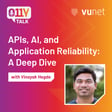
Episode 3: Building Resilient Systems: SRE Best Practices and Insights
In this episode of Observability talk, we look at Observability from the perspective of building resilient systems through site reliability engineering. We explore the origin of the position and move into understanding the best practices, the divergent nature of reliability across organizations, and the experience of being in the trenches of problem-solving.
We are joined by Safeer CM, a seasoned technology leader specializing in site reliability, DevOps, and platform engineering. Safeer has worked for organizations like LinkedIn and Flipkart and has a solid background in cloud and infrastructure management working with large-scale internet companies and startups. He has also authored a book titled “Architecting Cloud-Native Serverless Solutions”.
Also Check Out
- Safeer’s Website, LinkedIn and Twitter
- Architecting Cloud-Native Serverless Solutions (Amazon)
For more information visit VuNet Systems













